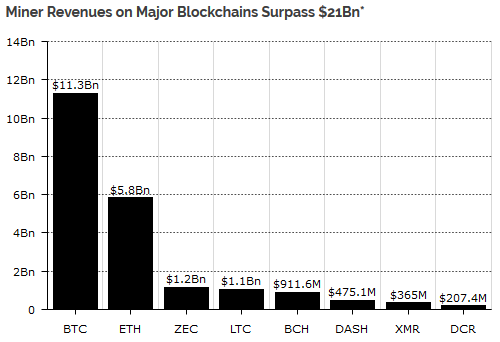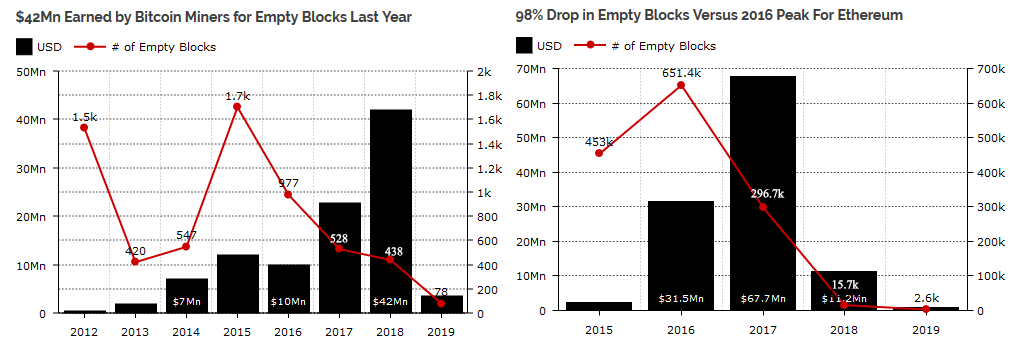Ever since the first blockchain was launched ten years ago, cryptocurrency miners have managed to earn over $21 billion by participating in the consensus protocol. Interestingly enough, around 16 percent of the total reward is based on mining empty blocks and bringing no real value to the network.
Once upon a time, a simple laptop was more than enough to mine on the Bitcoin (BTC) blockchain and earn the reward of 50 BTC per block. However, as more and more joined the decentralized network, the mining difficulty adjusted and an average CPU wasn’t enough anymore.
On Oct 1, 2010, Bitcointalk user ‘m0mchil’ released the code for mining BTC using a video card (GPU). As the difficulty level and power requirements continued to rise, the need for more advanced mining hardware became evident and, by June 2011, Field-Programmable Gate Arrays (FPGAs) were becoming quite popular.
SponsoredThe biggest advantage of FPGAs was the fact that they used three times less energy than GPUs. Nevertheless, they would give way to Application Specific Integrated Circuit (ASIC) machines that moved mining Bitcoin from being a hobby to a true industrial activity. To date, ASICs remain the standard, as they are created for the sole purpose of mining cryptocurrencies. They are expensive and represent the only profitable way to mine Bitcoin.
How profitable? According to Diar – a weekly newsletter analyzing the world’s digital assets industry – the business is booming, with over $11.3 billion in rewards earned by miners in the last ten years.
#Cryptocurrency miners have earned north of $21Bn since the start of major #blockchain networks. More in this week's Diar: https://t.co/iCPahR6qv9 pic.twitter.com/Ur1XMJSSei
— Diar (@DiarNewsletter) February 26, 2019
Bitcoin Mining Dominates Ethereum Mining
In total, cryptocurrency miners from around the world earned over $21 billion in rewards, as per Diar’s report.
Bitcoin miners have earned more than half of the total mining rewards ($11.3 billion), followed by Ethereum (ETH) with $5.8 billion.
Sponsored SponsoredCurrently, Ethereum is based on Satoshi Nakamoto’s patented Proof-of-Work (PoW), just like Bitcoin.

PoW is a protocol where miners compete to solve complex mathematical problems. The protocol uses extensive computational resources and burns vast amounts of energy as a result.
The miners on the Ethereum blockchain were rewarded three ether per block just a few days ago but, with the Constantinople Hard Fork activated, the reward has been cut to two ether. These incremental cuts (from five ether to three ether in October 2017 as part of the Byzantium Hard Fork and from three to two ether with the implementation of Constantinople) are part of a bigger plan to shift the algorithm from PoW to Proof-of-Stake (PoS).
PoS is a protocol where the creator of a new block is chosen in a deterministic way depending on the amount of wealth they have at stake. It’s much more cost-effective and environmentally friendly.
SponsoredNumber eight in the chart, Decred (DCR) uses PoS alongside PoW in a unique hybrid system called Proof-of-Activity (PoA). Dash — $475.1 million in mining revenues since its launch in January 2014 — is a PoW-based cryptocurrency but also has a system of Masternodes that acts a second layer that facilitates more advanced functions. Just like in PoS, the masternodes must have skin in the game and are rewarded for their services.
Also worth mentioning is Monero (XMR), a cryptocurrency led by a development team that is not happy about ASICs. It upgrades the blockchain regularly to ensure that it remains ASIC resistant and prevents mining-hardware manufactures from developing miners that are compatible with the coin. Even so, XMR is seventh in the list with $365 million earned, thanks to GPU power and crypto-mining malware.

Proof-Of-Nothing (Or, How To Mine Empty Blocks For A Profit)
The report also analyzes the Proof-of-Nothing (PoN) effect.
Sponsored SponsoredPoN is the practice of mining empty blocks. Indeed, miners are rewarded for such an activity that basically brings no real value to the blockchain. The reward is consistent, with over $335 million earned over the years — the equivalent of $5 million per month.
Litecoin (LTC) is the big ‘winner’ in this category. The solution to add empty blocks into the blockchain brought the miners a hefty $125 million in profits. Ethereum is not far behind, with $113 million worth of PoN. Bitcoin follows with just over $100 million.
Luckily, the amount of empty-block mining has been declining steadily every year. Ethereum has managed to record the most progress with a 95 percent drop in 2018, compared to the peak initial coin offering (ICO) spam figures of 2017 — from $67.7 million to a little over $11 million.

Overall, the number of empty blocks have taken quite a plunge from a peak of around 1,700 in 2015 to just 438 empty blocks in 2018.
Will the top PoW-based cryptocurrencies enjoy mining at its fullest in 2019? What do you think? Have you participated in the mining process? How much have you earned? Share your thoughts in the comment section below!

